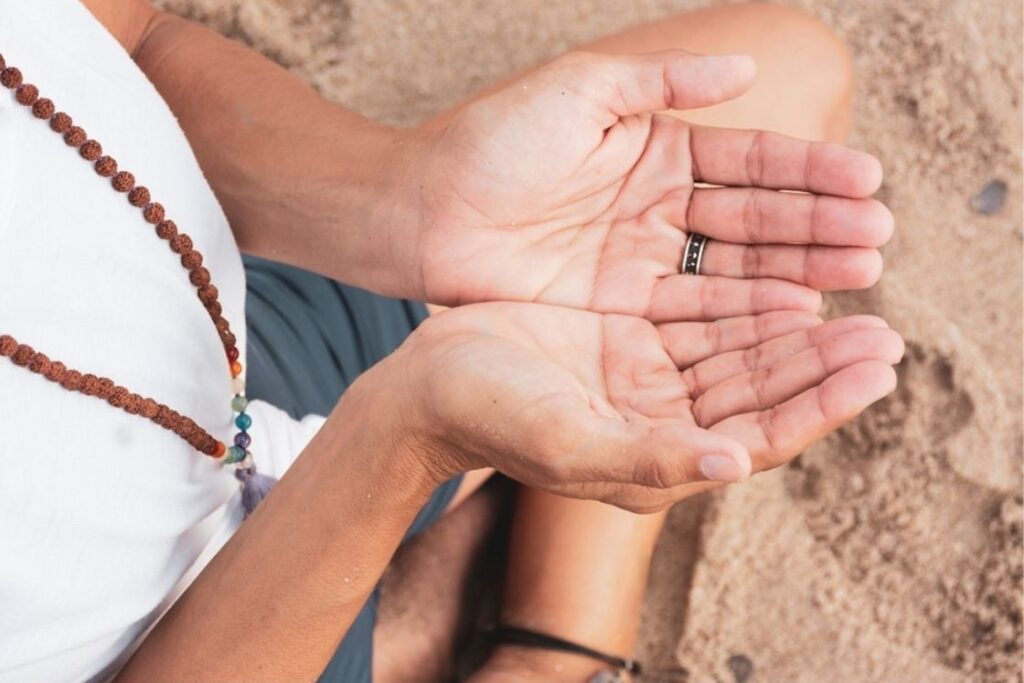
Pushpaputa Mudra is a symbolic hand gesture with origins in yoga, dance, and spiritual practices. Its name translates to “handful of flowers offered to God,” symbolizing a gesture of openness and acceptance. In various traditions, this mudra is associated with the act of offering or giving, similar to presenting a beautiful bouquet of flowers.
It is used in yoga asanas, meditation, and dance performances, where it carries spiritual and ritualistic significance. The mudra’s use can enhance concentration, self-confidence, and memory while promoting mindfulness and meditation. In Indian classical dance forms like Bharatanatyam, Pushpaputa Mudra is a vital component, conveying emotions and stories through its hand gesture.
Meaning & Culture Significance
Pushpaputa Mudra is a symbolic hand gesture with cultural significance in various traditions, particularly in the context of Hinduism and Indian classical dance. Here’s its meaning and cultural significance.
Meaning
Offering and Acceptance: Pushpaputa Mudra, derived from the Sanskrit words “Pushpa” (flowers) and “Puta” (offering), symbolizes the act of offering a handful of flowers to the divine. It signifies an open heart and a willingness to make offerings to the gods or deities as a gesture of devotion and acceptance of divine blessings.
Cultural Significance
- Hinduism
In Hinduism, Pushpaputa Mudra symbolizes openness of the mind and soul. The gesture is a way of offering with an open heart and accepting blessings. It is often used in rituals as an act of devotion, where flowers are offered to deities as a symbol of respect and reverence for the divine. It signifies the acceptance of divine grace and blessings.
- Buddhism:
Pushpaputa Mudra is also associated with Buddhism, where it represents the act of giving and offering. It symbolizes generosity and the willingness to share one’s blessings with others. In Buddhist meditation, it fosters a sense of abundance and a giving mindset, promoting selflessness and open-heartedness.
- Bharatanatyam Dance
Pushpaputa Mudra is an integral part of Bharatanatyam, a classical Indian dance form. Dancers use this mudra to depict offering and acceptance, which adds depth and emotional resonance to their performances. It can also symbolize the waving of lights as offerings to gods during dance performances.
How to Do Pushpaputa Mudra
- Sit in a comfortable meditation posture with your spine erect.
- Bring your hands together in front of your chest, with the little fingers touching each other. The rest of your fingers should be extended and slightly apart, creating a cupped shape with your hands.
- The palms of your hands should be facing upward, and your hands should be slightly hollow, resembling a bowl or a handful of flowers.
- Close your eyes and take a few deep breaths, focusing on the gesture of offering and acceptance that this mudra symbolizes.
- You can hold this mudra for as long as you like during your meditation or yoga practice, allowing it to cultivate a sense of openness and a willingness to make offerings to the divine.
- Slowly blink your eyes open to end the mudra practice.
Time & Duration
The recommended duration for practicing Pushpaputa Mudra is typically 15 to 45 minutes daily. You have the flexibility to complete this practice in one continuous session or break it into two separate sessions, each lasting about 15 to 20 minutes. It’s important to find a duration that suits your personal comfort and needs.
Mudras like Pushpaputa can be integrated into your morning meditation to enhance their benefits. However, it’s essential to maintain consistency in your practice to experience the potential effects of this hand gesture.
Affirmations
Affirmations can enhance your experience while practicing Pushpaputa Mudra, a gesture of openness and acceptance. Here’s an affirmation that aligns with the symbolism of this mudra.
“I am open to the beauty and abundance of life. My heart is receptive, and I offer love and gratitude to the universe. Like a handful of flowers, I extend my kindness and positivity to others.”
This affirmation complements the idea of Pushpaputa Mudra, which symbolizes offering and an open heart. You can repeat this affirmation silently or aloud during your practice to reinforce the sense of openness, acceptance, and giving associated with this gesture. Affirmations can help focus your intention and deepen your connection to the mudra’s meaning.
Pushpaputa Mudra Benefits
1. Openness and Acceptance
Pushpaputa Mudra is a gesture of offering with an open heart and acceptance of what comes your way. It promotes a mindset of receptivity and welcoming, which can be beneficial for mental well-being.
2. Spiritual Connection
In the context of yoga and meditation, Pushpaputa Mudra is associated with offering oneself like a handful of flowers to the divine. It can help individuals connect with their spiritual or inner selves.
3. Mental Calmness
The practice of this mudra can induce a sense of calmness and tranquility. It encourages individuals to let go of resistance and be more at peace with their thoughts and feelings.
4. Gesture of Giving
It is often regarded as a gesture of giving, which can be a reminder of the value of generosity and kindness in one’s life. This can have positive effects on one’s relationships and interactions with others.
5. Subtle Energetic Effects
While the physical effort required is minimal, the energetic impact can be substantial. Pushpaputa Mudra is believed to release pent-up energies, promoting a sense of release and freedom
Conclusion
Pushpaputa Mudra practice can lead to a deeper spiritual connection, greater mental calmness, and a profound sense of openness and acceptance. This symbolic hand gesture, originating from yoga, dance, and spiritual traditions, invites you to offer yourself, like a handful of flowers, to the divine.
As you sit in a comfortable meditation posture, cup your hands together, and let the energy of this gesture flow, you’ll find a pathway to inner peace and self-discovery. Whether you’re drawn to its significance in Hinduism, Buddhism, or Indian classical dance, the universal message remains one of giving, openness, and receiving blessings.
So, begin your journey with Pushpaputa Mudra today, and let it infuse your life with the beauty and abundance it signifies. Embrace the power of this gesture, and watch as it transforms your connection to the spiritual realm and your inner self.
Open your heart and offer your intentions, just like a handful of flowers, and discover the boundless blessings that await you on this sacred path.




